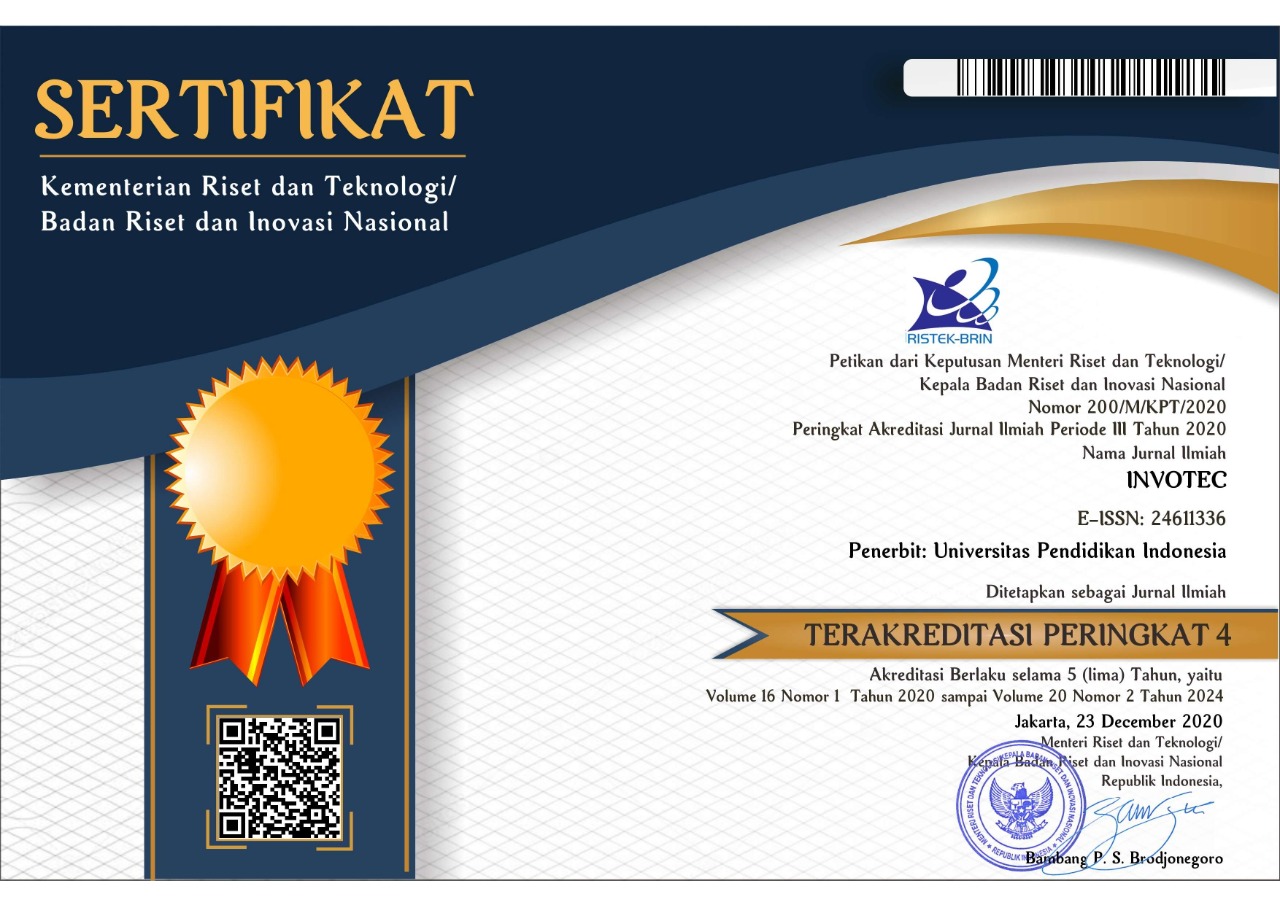The Instrumental Framework to Measuring Environmental Awareness
Abstract
Environmental awareness needs to be increased because it plays an important role for the survival of life. To find out the level of public awareness of the environment it is necessary to conduct a workshop or environmental awareness training. The purpose of this study is to identify and generate an instrument indicator to measure the environmental awareness. This article looks at a variety of relevant literature in order to explore the aspects that must be present In the instrument to measuring the environmental awareness level. The literature study results are obtained the aspects that must have to consist of two aspects namely pro-environment and not pro-environment, in which indicators are made from the start of knowledge, attitudes and behavior. The implication of this literature review is to provide information and recommend a set of a framework to academics in making instruments measuring the level of public awareness of the environment.
Keywords
Full Text:
PDFReferences
Albertini, E. (2013). Does environmental management improve financial performance? A meta-analytical review. Organization & Environment, 26(4), 431-457.
Anbalagan, G., and Srivastava, R. (2016). Developing Environmental Awareness through Open and Distance Learning System. Pakistan Journal of Distance and Online Learning, 1(1), 49-57.
Arlt, D., Hoppe, I., and Wolling, J. (2011). Climate change and media usage: Effects on problem awareness and behavioral intentions. International Communication Gazette, 73(1-2), 45-63.
Ballantyne, R., Packer, J., and Falk, J. (2011). Visitors' learning for environmental sustainability: Testing short-and longterm impacts of wildlife tourism experiences using structural equation modeling. Tourism Management, 32(6), 12431252.
Belinda, Y. (2017). The Influence of Public Awareness of the Environment on the Community's Interest in Saving at the Sawo Kecik Garbage Bank Housing the Gebang Permai Temple in Yogyakarta. Thesis: Sanata Dharma University.
Cetin, G., and Nisanci, S. H. (2010). Enhancing Students' Environmental Awareness. Procedia-Social and Behavioral Sciences, 2(2), 1830-1834.
Chen, X., Huang, B., and Lin, C. T. (2019). Environmental awareness and environmental Kuznets curve. Economic Modelling, 77, 2-11.
Culiberg, B., & Rojšek, I. (2008). Understanding environmental consciousness: a multidimensional perspective. Grbac: poglavlje u knjizi.
Douglas, A. C., Mills, J. E., Niang, M., Stepchenkova, S., Byun, S., Ruffini, C., ... and Blanton, M. (2008). Internet addiction: Meta-synthesis of qualitative research for the decade 1996–2006. Computers in human behavior, 24(6), 3027-3044.
Flammer, C. (2013). Corporate Social Responsibility and Shareholder Reaction: The Environmental Awareness of Investors. Academy of Management Journal, 56(3), 758-781.
Ham, M., Mrčela, D., and Horvat, M. (2016). Insights for Measuring Environmental Awareness. Ekonomski Vjesnik: Review of Contemporary Entrepreneurship, Business, and Economic Issues, 29(1), 159-176.
Hartmann, P., and Apaolaza-Ibáñez, V. (2012). Consumer Attitude and Purchase Intention toward Green Energy Brands: The Roles of Psychological Benefits and Environmental Concern. Journal of Business Research, 65(9), 1254-1263.
Haslinda, A., and Fuong, C. C. (2010). The implementation of ISO 14001 environmental management system in manufacturing firms in Malaysia. Asian Social Science, 6(3), 100.
Hiramatsu, A., Kurisu, K., and Hanaki, K. (2016). Environmental Awareness in Daily Activities Measured by Negative Prompts. Sustainability, 8(1), 24.
Hsieh, H. F., and Shannon, S. E. (2005). Three approaches to qualitative content analysis. Qualitative health research, 15(9), 1277-1288.
Husna, A. H., Ramadhani, E. A., Eva, D. T., Yulita, A. F., and Suhartono, E. (2014). The role formation of methylglyoxal, carbonyl compound, hydrogen peroxide and advance oxidation protein product induced cadmium in ovarian rat. Int J Chem Eng Appl, 5(4), 319-23.
Kubiszewski, I., Costanza, R., Franco, C., Lawn, P., Talberth, J., Jackson, T., and Aylmer, C. (2013). Beyond GDP: Measuring and achieving global genuine progress. Ecological Economics, 93, 57-68.
Kurniawati, A., Hardjanto, U. S., and Herawati, R. (2013). Air Quality Control in the City of Semarang. Diponegoro Law Journal, 2(3), 1-11.
Lafuente, R., and Sánchez, M. J. (2010). Defining and Measuring Environmental Consciousness. Revista International de Sociologia (RIS), 68(3), 731-55.
Lee, K. H., and Shin, D. (2010). Consumers' responses to CSR activities: The Linkage between Increased Awareness and Purchase Intention. Public Relations Review, 36(2), 193-195.
M. Wiernik, B., S. Ones, D., and Dilchert, S. (2013). Age and Environmental Sustainability: A Meta-Analysis. Journal of Managerial Psychology, 28(7/8), 826-856.
Murzi, H., Mazzurco, A., Pikaar, I., and Gibbes, B. (2019). Measuring development of environmental awareness and moral reasoning: A case-study of a civil engineering course. European Journal of Engineering Education, 1-15.
Nor, N. M., Bahari, N. A. S., Adnan, N. A., Kamal, S. M. Q. A. S., and Ali, I. M. (2016). The effects of environmental disclosure on financial performance in Malaysia. Procedia Economics and Finance, 35, 117-126.
Noviyanti, T., and Diharto, A. K. (2018). The Effect of Skepticsm and Environmental Concern on Green Purchase Behavior with Perceived Consumer Effectiveness as Variables of Mediation. Doctoral Dissertation, Institut Agama Islam Negeri Surakarta.
Peña-Fernández, A., González-Muñoz, M. J., and de los Ángeles Peña, M. (2015). Designing training for teaching environmental toxicology to specialized pharmacists. Currents in Pharmacy Teaching and Learning, 7(6), 864-868.
Perkins, H. E. (2010). Measuring Love and Care for Nature. Journal of Environmental Psychology, 30(4), 455-463.
Phan, T. N., and Baird, K. (2015). The Comprehensiveness of Environmental Management Systems: The Influence of Institutional Pressures and the Impact on Environmental Performance. Journal of Environmental Management, 160, 45-56.
Salim, E. (1982). Conservation and development. Environmentalist, 2(2), 109-116.
Sudarman, S., Saputra, D. D., Karnowo, K., and Febrian, F. (2019). Minimization 0f Air Pollution Through Sustainable Development of Eco-Industrial Parks in China Effects of Managers' Environmental Awareness on The Relationship Between Practice and Performance. Rekayasa: Jurnal Penerapan Teknologi dan Pembelajaran, 16(2), 165-172.
Waskito, J., and Harsono, M. (2012). Green Consumer: Description of the Joglosemar Community's Level of Awareness and Concern for Environmental Sustainability. Journal of Management Dynamics, 3 (1).
Wells, V. K., Manika, D., Gregory-Smith, D., Taheri, B., and Mc Cowlen, C. (2015). Heritage Tourism, CSR and the Role Employee Environmental Behavior. Tourism Management, 48, 399-413.
Zareie, B., and Navimipour, N. J. (2016). The impact of electronic environmental knowledge on the environmental behavior of people. Computers in Human Behavior, 59, 1-8.
DOI: https://doi.org/10.17509/invotec.v15i2.19638
Refbacks
- There are currently no refbacks.
Copyright (c) 2019 Innovation of Vocational Technology Education

This work is licensed under a Creative Commons Attribution-ShareAlike 4.0 International License.
This journal provides immediate open access to its content on the principle that making research freely available to the public supports a greater global exchange of knowledge.

This work is licensed under a Lisensi Creative Commons Atribusi-BerbagiSerupa 4.0 Internasional.


